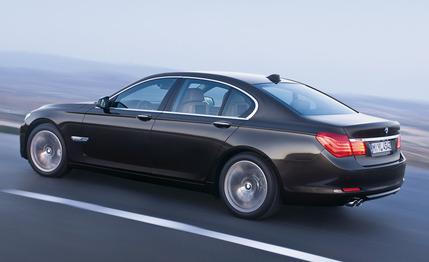
 Second Drive
Second Drive
While the new fifth-generation 7-series continues to be BMW’s technological pacesetter—it gets even more high-tech features such as variable suspension damping, rear-wheel steering, night vision with pedestrian detection, and side-view cameras—the real buzz at its introduction was BMW’s backpedaling away from some of the previous big car’s, uh, “breakthroughs.”
Last time around, for the 2002 model, BMW thoroughly shuffled the ergonomics of the 7-series, switching the shifter from the center console to a newfangled lever on the steering column, as well as moving the seat controls to the center console and programming them as some sort of demented test of logic. Both items have now been returned to their previous locations.
Furthermore, the most controversial piece of technology, iDrive, with its multifunction central control knob that has been copied to varying degrees by Mercedes, Audi, and Honda, has been completely overhauled. In fact, continuing to call it iDrive is almost an insult to its vastly improved control strategy. There’s no more convoluted nudging of the knob in one of eight directions to choose a submenu; now you scroll straightforwardly through a list and click to select. Shortcut buttons surrounding the knob ease the acclimation process, and the climate controls have been removed from iDrive altogether.
But that’s not to say the 7-series isn’t complex. In what must be a tuning nightmare for chassis engineers, the new car has standard electronically controlled dampers that vary compression and rebound characteristics independently, as well as available active anti-roll bars. Also new are an unequal-length control-arm front suspension and rear-wheel steering, which is bundled with the familiar and optional ratio-varying active steering.
At speeds below 37 mph, the rear wheels turn up to three degrees in the opposite Âdirection of the fronts, which reduces the turning circle by as much as 2.3 feet. At higher speeds, the rears swivel in the same direction as the fronts to improve responsiveness. We drove prototypes with all of these available goodies at BMW’s proving ground in Miramas, France, and they certainly felt capable and willing, with lighter steering effort more in line with that of a 3-series, helping the big sedan feel much smaller from behind the wheel. BMW’s über-sedan was already dynamically sound, and it appears poised to stay ahead of the pack; this is a luxury sedan that doesn’t shy away from hustling.
The car accommodates varying tastes via four settings (Comfort, Normal, Sport, and Sport +) that alter the damping rates, steering effort, shift points, and stability-control intervention threshold. A fifth mode is achieved by simply switching off the stability control. The various settings provide tangible differences, with Comfort yielding a softer ride than is BMW-typical and Sport + allowing moderate sideways action as long as steering and throttle inputs remain measured. On a wet-handling course, the 7-series was inspiringly well balanced and eager to dance.
On sale in March 2009, the 7-series should start at about $80,000 and will be available in 750i and long-wheelbase 750Li guises. Despite the carry-over names, there is a new engine—the 400-hp, 450-pound-feet, direct-injection twin-turbo 4.4-liter V-8 that recently debuted in the top-of-the-line X6. That’s 40 horsepower and a whopping 90 pound-feet more than the previous 750i’s 4.8-liter V-8. Flooring the throttle generates a torquey turbo shove; we’re betting on a quickest-in-class 0-to-60-mph time in the high-four-second range. The six-speed ZF automatic gearbox carries over for now, although a new eight-speed likely will be added in a year or so. BMW says fuel economy improves by three percent over that of the outgoing 750i/Li, rated at 15/23 mpg city/highway. Torsional rigidity is up 20 percent, and curb weight increases 70 pounds to nearly 4600 despite extensive use of aluminum.
Models that won’t be sold in the U.S.—at least not initially—are the 740i/740Li with a more powerful, 322-hp version of the twin-turbo 3.0-liter six and the 730d with its new 241-hp, 3.0-liter diesel.
BMW has reacted to another sore point of the previous car—its styling—by going a more conservative and evolutionary route both inside and out. The exterior is spruced up with a strong crease that runs the length of the car, and the trunklid is far less bulbous. Bumper-mounted exhaust tips appear to be a near copy of the Lexus LS460’s.
There’s no question that the new 7-series will be a fierce competitor dynamically and, with much improved ergonomics, is now easier to use. To say that it’s more appealing than its predecessor is perhaps faint praise; the real question will be whether it has what it takes to stand out in the impressive luxury-flagship crowd.